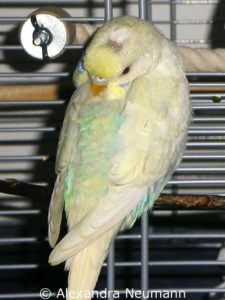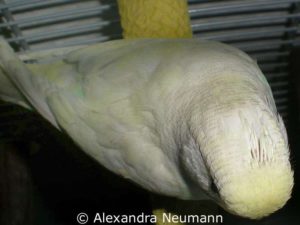- >>
- Birds Online – English
- >>
- Health and diseases
- >>
- Plumage disorders and moult
- >>
- Bald head
Bald head
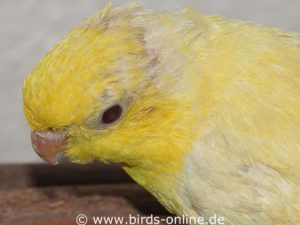
Some birds show a perfect plumage, but the back of their head is bald. In many of them, the plumage gets visibly more patchy there over time in this zone of their body. So it is a gradual process that slowly leads to partial baldness. In many cases, the affected animals are birds living in an intimate partnership with a conspecific. Often it is the partner who plucks out the feathers while grooming the other bird. Why this happens varies from case to case. Therefore, this type of feather plucking is difficult to treat. Except perhaps by separating the partners, but that would mean stress for them.
In other cases, the birds do not purposefully pluck out the feathers. However, they groom their partner so frequently on the back of the head that the plumage can no longer withstand this strain over time – the feathers drop out. You have to deal with over-grooming which may occur in bonded birds. This excessive behaviour can be based on psychological stress. It is very difficult to diagnose this. Only in very rare instances, extreme moulting causes the back of the head to become bald while the rest of the plumage is intact. If not only the back of the head is bald, but other parts of the body are also affected, a viral infection such as PBFD could be responsible for the loss of plumage.
Most of the time we are dealing with a phenomenon caused by grooming or feather plucking. In principle, all birds can be affected, but this particular kind of bald head is more common in some species than in others. We can observe it quite often in species such as Cockatiels and Lineolated parakeets. Budgies rarely pluck the feathers on the back of their partner’s head while grooming, but you should never say never.
Why do birds pluck feathers from their partners’ heads?
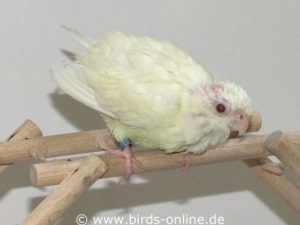
One of the most common reasons for a bird to pluck feathers from its partner’s head is sexual frustration. As contradictory as this may sound at first: It is often seen when the birds are doing very well and would like to reproduce. So their breeding instinct is stimulated, but they are cannot carry it out although the necessary conditions in housing and nutrition would be given. This creates inner tension, which some birds relieve by plucking feathers from their partners. In such cases, it can help to let the birds breed. Or you can try to bring the birds’ hormone levels back to normal by changing the environmental conditions.
Many small parrots, including budgies, react very strongly to the duration of daylight. By reducing the time your birds are exposed to daylight and artificial light, you can try to cool them down hormonally. Budgies and cockatiels, for example, should sleep at night for at least twelve hours. If you provide this, they usually calm down and get back to normal. This can sometimes reduce or even completely prevent feather plucking. In addition, the diet should be less rich in fat and protein, because this measure also prevents the birds from getting into a breeding mood. But make sure that the birds are still supplied with sufficient nutrients.
Also bear in mind that sexual frustration is only one possible reason for plucking the partner’s feathers. Other causes come into consideration, too. Birds who are constantly under stress, for example, because they feel threatened by their owners or other pets, may use feather plucking to relieve internal tension. Or birds who cannot get any rest at night because they are frequently disturbed while sleeping may tend to show this unwelcome behaviour.
Is a bald head dangerous?
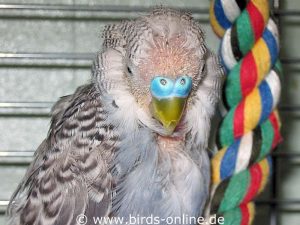
If a bird has bald patches on his or her head because the partner plucks the feathers or is too ambiguous when it comes to preening, this is usually no health risk. Provided the partner is not overly aggressive and does not injure the bird, there is no further danger. Usually, new feathers grow back quickly. However, if the partner maintains this behaviour for a very long time, the feather follicles may become damaged. Then, no new feathers will grow and the head will remain bald (at least partially). Because it can be stressful for a bird to be plucked by his or her mate, there is nevertheless cause for concern: Prolonged states of stress, possibly increased by the fact that the breeding instinct cannot be acted out, put a strain on a bird’s organism. This usually results in a weakened immune defence. Some birds may also develop eczema or skin inflammation on their head because their bare skin is overstimulated.
If the head is bald because of a major underlying disease this symptom should be taken seriously. It reflects the poor health condition of the affected bird. So, in case a bird shows a bare head and no partner plucks the feathers or grooms them too much, other causes should be investigated. This is even more important if bald patches develop not only on the head, but further feather loss occurs on the rest of the body.
An avian vet should clarify as soon as possible whether, for example, a viral disease such as PBFD or French moult (Polyomavirus) causes the symptoms. In addition, parasites such as feather mites can sometimes be responsible for plumage damages. Also, in some cases, a testosterone deficiency (testosterone = male sex hormone) can be the reason if a male bird shows bald patches on his head. Especially in cockatiels, this can frequently be seen.
Fighting among birds
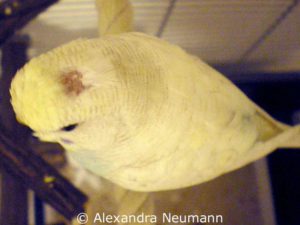
Some birds are quite impulsive and argue violently with their conspecifics. This can be observed fairly often in budgies, for example. During such fights, they sometimes tear out tufts of feathers from their opponents. Because in many cases they direct their attacks at the opponent’s head, several feathers may be missing there afterwards. Young birds who have already left the nest but still seek the closeness of their parents and push them while begging for food and affection are sometimes attacked. It is not uncommon for adults to tear out feathers from their chicks’ heads.
Bald patches caused by feather loss due to violence usually appear very suddenly. It usually takes only a few days for new feathers to form and the gap in the plumage to close again. There were just a few days between the two photos below these lines have been taken.

